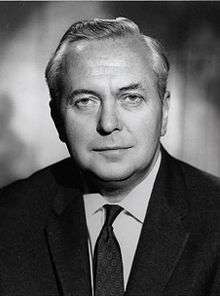Clockwork Orange (plot)
Clockwork Orange is the name of the secret British security services project which was alleged to have involved a right-wing smear campaign against British politicians from 1974 to 1975.[1] The black propaganda led Prime Minister Harold Wilson to fear that the security services were preparing a coup d'état.[2] The operation takes its name from A Clockwork Orange, the 1971 Stanley Kubrick film.
The project was undertaken by members of the British intelligence services and the British Army press office in Northern Ireland, whose job also included routine public relations work and placing disinformation stories in the press as part of a psychological warfare operation against the Provisional Irish Republican Army. One of the project's members, Colin Wallace, who was the press officer at the Army Headquarters in Northern Ireland, also claims that in 1973, after MI5 became the primary intelligence service in Northern Ireland, the project began giving briefings to foreign journalists against members of Wilson's government. These briefings included distributing forged documents in an attempt to show that the victims were communists or Irish republican sympathisers leading a campaign to destabilise Northern Ireland[3] or were taking bribes.
After his resignation, Prime Minister Harold Wilson claimed that he was the target of a planned military coup. He also denounced a campaign to smear him staged by members of MI5 in order to force his resignation.[4][5] According to journalist Barry Penrose "Wilson spoke darkly of two military coups which he said had been planned to overthrow his government in the late 1960s and in the mid 1970s."[4]
In January 1974 the British Army carried out Operation Marmion, the occupation of London Heathrow Airport on the grounds of training for possible violent non-state actor activity at the terminal,[6] without Wilson's foreknowledge.[7] The operation was repeated on three more occasions in June, July and September. These military deployments were perceived as a practice-run for a military takeover rather than an anti-terrorist exercise.[6]
Airey Neave, the Conservative Member of Parliament (MP) was alleged to have been involved with Clockwork Orange, and to have briefed Wallace on a number of occasions.[8]
Other than Wallace's testimony, the primary evidence for the existence of this plot consisted of a series of handwritten notes taken by Wallace in meetings with other members of the plot. Journalists investigating Wallace's story had these notes analysed by a forensic scientist, and the results were found to be consistent with the notes having been taken contemporaneously.
In the House of Commons, on 30 January 1990, junior defence minister Archie Hamilton, admitted the existence of a project called Clockwork Orange, although he claimed that there was no evidence that this project involved a smear campaign against politicians.[9]
References
- ↑ Thomas, Rosamund M. (1991). Espionage and Secrecy: The Official Secret Acts 1911-1989 of the United Kingdom. p. 148. ISBN 0415040671
- ↑ O'Malley, Brendan and Craig, Ian (2001). The Cyprus Conspiracy: America, Espionage and the Turkish Invasion. I.B. Tauris, p. 149. ISBN 1860647375
- ↑ Steiner Verlag, Franz (2006). Conspiracy Encyclopedia. Thom Burnett, pp. 158-159. ISBN 1843403811
- 1 2 Wheeler, Brian (9 March 2006). "Wilson 'plot': The secret tapes". BBC News.
- ↑ Simon, Tomlin (2009). Sons of Soldiers. p. 177. ISBN 1427641951
- 1 2 Hughes, Geraint (2011). The Military's Role in Counterterrorism: Examples and Implications for Liberal Democracies. Strategic Studies Institute. p. 91. ISBN 1584874899.
- ↑ Freedland, Jonathan (15 March 2006). "Enough of this cover-up: the Wilson plot was our Watergate". The Guardian. Retrieved 2 April 2015.
- ↑ Norton-Taylor, Richard (1990). In Defence of the Realm?: The Case for Accountable Security Services. Routledge, p. 93. ISBN 0900137312
- ↑ Hansard, 30 January 1990, Column 108
- Paul Foot, Who framed Colin Wallace? (1989)
- Peter Wright, Spycatcher (1987)
